If the last few years have taught us anything, it’s that diverse representation matters. Discussions of inclusivity in various industries have even permeated mainstream media, but there’s one example which often goes unmentioned: the porn industry. This shouldn’t come as a surprise. A global political shift towards conservatism means that plenty of high-profile politicians have spent recent years calling for a ‘crackdown’ on porn consumption, but regular surveys show that we’re still a world full of horn-dogs determined to ignore this resistance.
Despite the puritanical attempts to stop us all jerking off, we’re obviously still consuming porn on a regular basis; so, if the vast majority of us are watching it, why shouldn’t we be questioning it?
Even a cursory analysis of the industry reveals multiple problems. A disturbing number of scenes still feature simulated sexual assault, whereas porn’s treatment of trans women and people of color is almost always terrible – think fetishization, exploitation and gross, archaic labels like ‘BBW’, ‘Ebony’ and ‘Shemale’. But amongst these misguided representations, there is one group which, historically, has barely been represented on-screen at all: trans men. It only takes a quick glance at the ‘trans porn actors’ page of Wikipedia to see the clear gender disparity: there are twenty-one trans women listed, and only one trans man.
This sole male voice is actor, educator and motivational speaker Buck Angel, otherwise known – according to his official website – as the ‘Famous Man with a Pussy’. He broke into the adult film industry way back in 2002, and immediately took a hands-on approach to remedying a lack of visibility. Angel performed and starred in his own films, revolutionizing the industry: “There was no one like us in mainstream porn,” he explains to INTO, “So I made a name for myself whilst also bringing visibility to trans men in porn.”
In 2005, he scored a landmark role in Cirque Noir, a clip which features Angel alongside cis, gay male actors. The film was distributed by an all-male gay porn studio Titan Media, a point whose magnitude cannot be understated – earlier this year, INTO wrote about the controversy surrounding a similar clip, ‘Some Men Have Pussies’, starring trans actor Cyd St. Vincent.
It’s worth pointing out here that some trans people undergo gender realignment surgery whereas others don’t – both choices are obviously valid, but you know this already. In the context of mainstream porn, this is an important fact; the industry is built on strict, often exclusionary beauty standards, so deviating from the binary mold prescribed to porn stars is radical by default. We don’t see trans bodies represented often enough, which means that many still grapple with the idea of being attracted to them.
Model and actress Hari Nef summarized this fact back in 2015, explaining: “Trans people before gender confirmation surgery, those are non-binary bodies. You don’t learn how to fetishize those bodies out in the open. Trans porn is the number one fastest growing porn industry, and the trans body has been being consumed in private in America for years and years by many people. But this is something important, and the core of violence against trans women: men don’t understand that their attraction to trans women is a valid attraction.”
There are now websites dedicated to positive and accurate representation of trans bodies – representation which has never been more crucial, given ongoing media misrepresentation and the disproportionately high rates of violence and harassment against trans people. PinkLabel.TV is just one example; founded by director Shine Louise Houston, the site provides a platform to numerous studios, some of which – T-Wood Pictures, Bonus Hole Boys and Buck Angel Entertainment are just a few examples – center gender-diverse bodies and, often, trans men.
“Transmasculine content continues to be what is considered a ‘niche’ section of the adult film industry, but it has a growing fanbase,” explains Jiz Lee, Marketing Director at Pink and White Productions. “It also has a growing number of producers, as affordable production equipment and hosting platforms like PinkLabel.TV have allowed access for emerging producers to put their works online with less financial and technical obstacles.”
Angel agrees emphatically with this statement. “There are very few obstacles, if any, now, and I can tell you this from experience; when I started, the porn business would have nothing to do with me. I fought hard to get where I am, but the door has been opened.” The last few years have also seen the creation of BuckAngelCams.Com, a webcam site which allows trans men to sign up and broadcast online. “They can work from home – I can’t see any easier way to get into porn!”
So, if there are fewer technical and financial obstacles than ever blocking trans men from entering the porn industry, why are there still comparatively few examples? A quick search through Pornhub reveals that there are approximately 20,000 more clips featuring trans women than there are trans men – the options may be there, but visibility is still scarce. Angel admits he’s equally baffled: “There is much more opportunity to produce your own porn now than when I started, which is why I’m not sure why there isn’t more representation.”
Lee points to a lack of profitability as a part of the answer: “Unfortunately, small to mid-sized studios are having a harder time profiting, as piracy on ‘free’ tube sites has had a devastating impact on industry sales. Transmasculine content is not immune.” They point to a series of ethical solutions – digital fingerprinting, DMCAs and a lack of download options are just a few, and reiterate their optimism: “We hope to continue to offer an ethical place where viewers can pay for porn that supports creators, helps them gain audiences and allows them to continue to create inclusive content.”
Crucially, more and more creators seem aware that positive, accurate representation is needed – if there isn’t quantity, there needs to be quality. “I do think representation is fair given the lack of it,” explains Angel. “Those of us who do create it and put it out there use our visions of what we want to see, so to me that constitutes fair, but there will be trans people out there who think differently. What I always say is that, if you do not like what you see, or if something is lacking, then please make an effort to change it positively. Please do not point fingers at those of us who are making the effort.”
Angel’s words make sense: there are an increasing number of queer film studios creating high-quality productions and working to remedy the erasure we’ve historically seen of trans men, but things still need to shift further. There are now resources, financial shortcuts and an increasing demand for trans men on-screen, all of which should translate to a rise in popularity. The fact that this still isn’t the case might signify that ongoing societal stigma is simply too strong to fight against en masse, or it could just signal a lack of trans men willing to actually step in front of the screen. Whatever the problem, now is the time to question it; as conversations around trans bodies increase in both frequency and intensity, there’s never been a more opportune moment to seize control and create the representation we want to see on-screen.
Help make sure LGBTQ+ stories are being told...
We can't rely on mainstream media to tell our stories. That's why we don't lock our articles behind a paywall. Will you support our mission with a contribution today?
Cancel anytime · Proudly LGBTQ+ owned and operated
Read More in Culture
The Latest on INTO
Subscribe to get a twice-weekly dose of queer news, updates, and insights from the INTO team.
in Your Inbox













